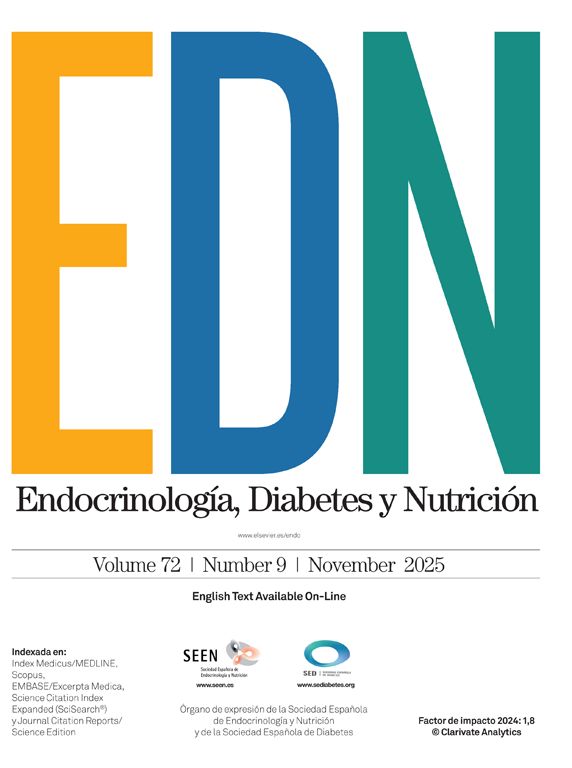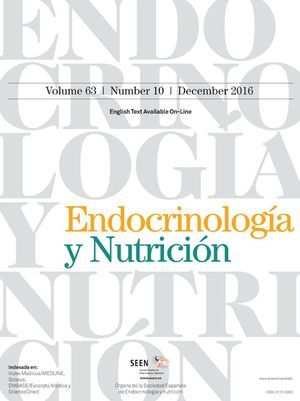In March 2020, the WHO recognised the disease caused by the SARS-CoV-2 virus as a global pandemic. The disease caused by this new virus was named COVID-19 by international consensus. Among the treatment protocols for this disease is lopinavir/ritonavir1, an antiretroviral drug commonly used in the treatment of HIV.2
Patients affected by COVID-19 present high nutritional risk due to the increased requirements in the context of acute and severe inflammation, in addition to the difficulty covering these requirements because of hyporexia and various feeding difficulties that may appear. The most prevalent general symptoms are cough, myalgia and loss of appetite, although there are some otorhinolaryngological symptoms especially related to this disease that can affect appetite and eating, such as facial pain, nasal congestion or anosmia and ageusia.3 Several societies such as ESPEN and SEEN (Sociedad Española de Endocrinología y Nutrición [Spanish Society of Endocrinology and Nutrition]),4,5 recommend that, if the requirements are not met despite nutritional supplementation, patients be assessed as to whether they require enteral nutrition, either complementary to oral or complete. Also, because the lopinavir/ritonavir oral solution contains alcohol, in the SEEN document,5 in addition to the recommendations that have been provided for different hospital protocols, and following the recommendation of the summary of product characteristics (SmPC),2 it is suggested that administration through polyurethane tubes be avoided (due to their potential incompatibility with the hydroalcoholic solution of lopinavir/ritonavir), proposing instead the use of silicone or polyvinyl tubes.
Until about 25 years ago, only polyvinyl or polyethylene tubes, poorly biocompatible and of large calibre, were used to administer nutrition, but these can cause complications, such as erosions and incompetence of the lower oesophageal sphincter, and are more suitable for gastric aspiration than for nutrition. Currently, more flexible and biocompatible materials such as polyurethane or silicone are used, which are less affected by digestive secretions, cause less discomfort to the patient, allow for smaller diameter tubes, do not cause allergic reactions and produce fewer erosions in the mucosa, enabling the length of time a tube can stay in the gastrointestinal tract to be extended to 4-6 weeks. Silicone is softer and more flexible, so it is very well tolerated, but it is more difficult to insert and tends to collapse. For all these reasons, the material of choice for nasogastric enteral nutrition tubes is polyurethane, as it is more resistant, with thinner walls and thus a greater internal diameter for the same external diameter.6
The SmPC for lopinavir/ritonavir2 states that the tablet form cannot be crushed and indicates that the oral solution should be used for tube administration. It also recommends avoiding polyurethane since the oral solution of lopinavir/ritonavir (80 mg/20 mg per ml) contains alcohol at a 40% concentration2 and alcohol could affect the tube. Taking into account that the dosage regimen is 400 mg/100 mg (5 ml) every 12 hours2, if we were to dilute the 5 ml in 45 ml of water to get a 50 ml solution, we would obtain a solution with an alcohol concentration of 4%, which should be less aggressive for the polyurethane than the 40% solution. For its administration by nasojejunal tube, other authors recommend diluting the 5 ml of solution in 20 ml of water,7 thereby obtaining a 25 ml solution with an alcohol concentration of 10%. A guide to the administration of drugs by nasogastric tube endorsed by FELANPE (Federación Latino Americana de Terapia Nutricional [Latin American Federation of Nutrional Therapy])8 recommends administering this drug in its oral solution presentation via enteral tube, without commenting on the tube's material, as it can be administered directly through this tube, without dilution. On another note, it must be taken into account that the SmPC for lopinavir/ritonavir refers to the treatment of HIV infection and, therefore, to a chronic use of the drug, while in the treatment protocols for COVID-19 the maximum duration of the drug use would be 15 days,1 so the possible deterioration of the tube will necessarily be much less, and lower still if the solution is diluted as indicated above. In addition, polyvinyl tubes pose other problems, as we have commented on previously, which may be even more important in patients with COVID-19 (they are more rigid and would be more bothersome for procedures performed in these patients, such as non-invasive mechanical ventilation).
For all the above, we conclude that the protocols in which the use of polyvinyl tubes is recommended in COVID-19 patients receiving lopinavir/ritonavir should be changed to enable the use of the usual polyurethane tubes that constitute the material of choice for enteral nutrition.
Please cite this article as: Sirvent Segovia AE, Alfaro Martínez JJ. Administración de lopinavir/ritonavir a través de sonda de nutrición enteral. Endocrinol Diabetes Nutr. 2021;68:596–597.





